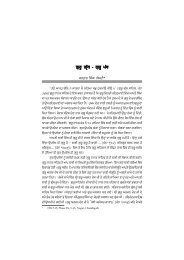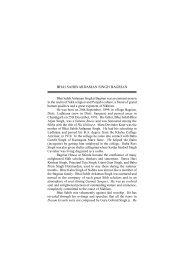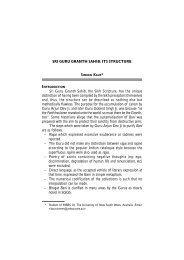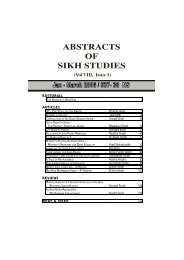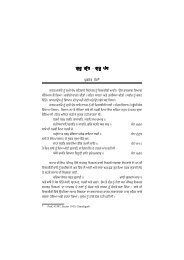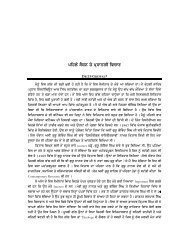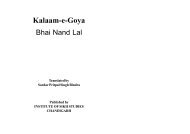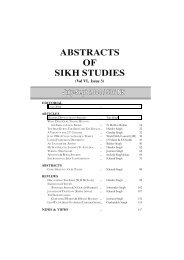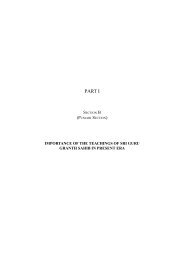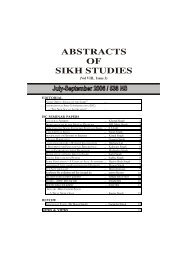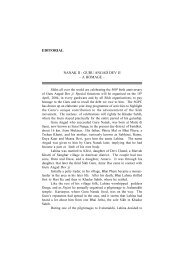editorial articles reviews news & views - Institute of Sikh Studies
editorial articles reviews news & views - Institute of Sikh Studies
editorial articles reviews news & views - Institute of Sikh Studies
Create successful ePaper yourself
Turn your PDF publications into a flip-book with our unique Google optimized e-Paper software.
112<br />
ABSTRACTS OF SIKH STUDIES : APRIL-JUNE 2005 / 537 NS<br />
knowledgeable reader is in a position to weigh up the merits <strong>of</strong> the<br />
modified perspective. However, there are chapters <strong>of</strong>fering no new<br />
perspective (e.g., Chapter 4 – “End <strong>of</strong> the Masand System and the Birth <strong>of</strong><br />
Khalsa” – and as such dot-less).<br />
Writer’s prose is crisp and distinct. He expresses his thoughts<br />
and arguments with economy. There are publishing oversights, such<br />
as, presenting the appendixes as chapters rather than as addendums or<br />
supplements and the odd printing mistake.<br />
In his otherwise excellent introduction, Dr Kharak Singh<br />
mistakenly <strong>views</strong> the book as an anthology; and, therefore, incorrectly<br />
concludes that the book “is not a systematic account <strong>of</strong> any particular<br />
period <strong>of</strong> <strong>Sikh</strong> history”. Rather, the book is an abstract <strong>of</strong> events that<br />
the author believes were chronicled on the bases <strong>of</strong> incomplete data.<br />
Born in a devout <strong>Sikh</strong> family, septuagenarian Sardar Harbans<br />
Singh Noor graduated from Punjab University <strong>of</strong> Lahore in 1943,<br />
choosing to make a career in journalism. He retired in 1984, after<br />
serving 26 years as Cultural Affairs Specialist with the United States<br />
Information Service, in New Delhi, to devote his life in the cause <strong>of</strong><br />
<strong>Sikh</strong>ism. He resides in Baltimore (USA).<br />
The author begins his quest by a fairly grim portrayal <strong>of</strong> Europe<br />
during Guru Nanak’s life. He describes an ecclesiastical Europe under<br />
the religious dominion <strong>of</strong> a corrupt papacy. The author blames Pope<br />
Sixtus lV for “establishing the Spanish Inquisition” that was intended<br />
to purify Spain and Portugal from heretics.<br />
In reality it was the devout Isabella, a Castillion, and Ferdinand,<br />
an Aragonese, who executed the Inquisition in order to wipe out the<br />
Jewish and Muslim religions from their domain. Pope Sixtus agreed to<br />
issue a papal bull only under threat <strong>of</strong> withdrawal by Ferdinand <strong>of</strong> the<br />
Spanish garrisons from Sicily.<br />
Most <strong>of</strong> the author’s “ethnic cleansing” and hounding <strong>of</strong> witches<br />
was confined to some territories within Spain, which was not yet a<br />
single state, but an amalgamation <strong>of</strong> reigns, and Portugal. These two<br />
regions do not a Europe make.<br />
Rather, Europe was emerging from the dark days <strong>of</strong> Middle Ages<br />
into an era known as the Renaissance that witnessed the introduction<br />
<strong>of</strong> print technology, flourishing <strong>of</strong> artistic, social, scientific, and<br />
political thought, and discovery <strong>of</strong> sea routes between all continents.



